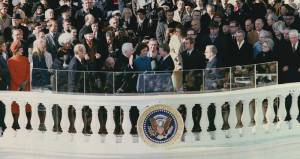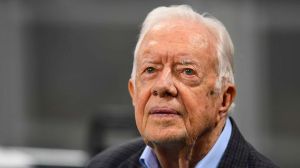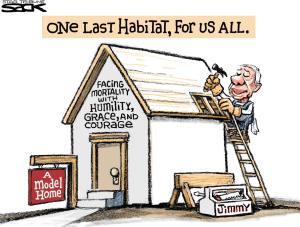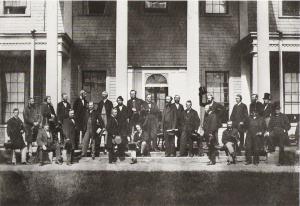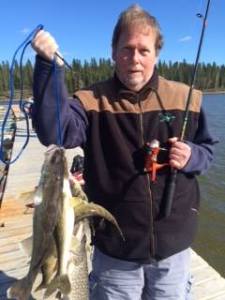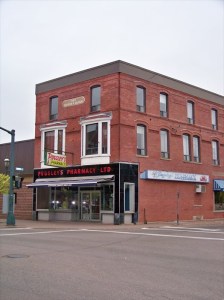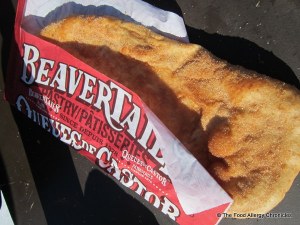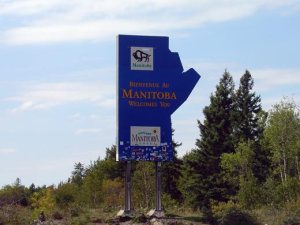
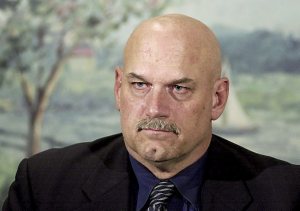
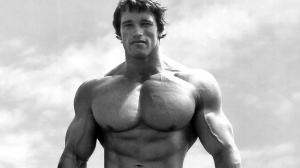
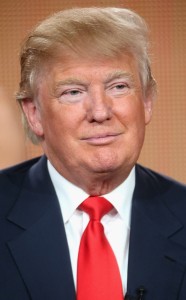
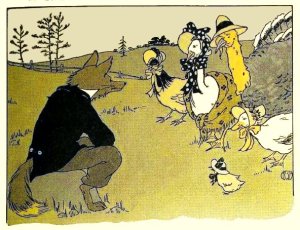
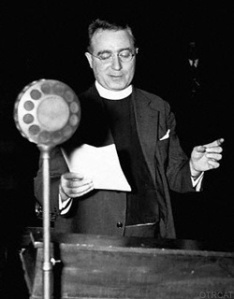
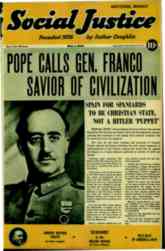
Consider the headlines for Sunday, July 17, 2016: CBS News is reporting in a July 16 its headline “W.Va. lawmaker: Hillary Clinton should be ‘hung’ on National Mall.” The story goes onto say, “A member of the West Virginia House of Delegates is causing a stir after tweeting that Hillary Clinton should be ‘hung on the Mall in Washington, DC.’
“CBS affiliate WOWK-TV reports that Michael Folk, a Republican legislator who is also a United Airlines pilot, posted a tweet Friday night saying: ‘Hillary Clinton, you should be tried for treason, murder, and crimes against the US Constitution… then hung on the Mall in Washington, DC.’”
Meanwhile, Charles P. Pierce has a July 14 piece in Esquire magazine, headlined, “This Isn’t Funny Anymore. American Democracy Is at Stake.” The subhead reads: “Anyone who supports Donald Trump is a traitor to the American idea.” Pierce writes at the top of the story that not “until Wednesday did we hear clearly the echoes of shiny black boots on German cobblestones.”
Really?
Is this the best we can do in terms of civics and public discourse in 21st century America? Call anyone we disagree with a traitor and perhaps for extra outrage allude to Hitlerism and Nazism? Is demagoguery the only currency we traffic in for what passes as ideas?
We stand at a dangerous international moment in history when an intersection of events conspire to resurrect Fascism on a scale not seen since the 1930s.
But the American republic can survive this difficult historical moment. Right-wing populism is not centralized authoritarian Fascism.
If Donald Trump wins the presidency in November, the world won’t end. I may not much like a Trump presidency, but the Supreme Court and Congress will not be dissolved [although Trump will probably make several nominations for upcoming vacancies on the bench that will make me wish the court had been dissolved. But that’s OK; Republican life appointments to the highest court in the United States often prove over time to be stubbornly independent, demonstrating you couldn’t have asked more from a Democratic appointee. It’s kinda complicated.]
Trump’s also unlikely to push the hot-war nuclear button, should he find himself ensconced in the Oval Office next January. Want to know what was really dangerous? The dance Democratic President John F. Kennedy, the living Legend of King Arthur and Camelot, had with Soviet premier Nikita Khrushchev during the Cuban Missile Crisis of October 1962. That was the almost the end of the world as you knew it. Right then and there. Not Donald Trump hyperbole.
There are plenty of examples in recent American history before where the crème de la crème cluck their tongues in displeasure at the electoral wisdom of the hoi polloi [think Brexit for the current British equivalent.] So what? Minnesota didn’t wind up seceding to Northwestern Ontario and amalgamating Duluth with Kenora when pro wrestler Jesse Ventura was elected and served as governor of Minnesota from January 1999 to January 2003.
California survived when Arnold Schwarzenegger, the Austrian-born American professional bodybuilder and movie actor wound up getting himself elected to serve two terms as governor of California from November 2003 until January 2011.
And speaking of California, an earlier Republican governor, Ronald Reagan, also a movie actor, went on from the statehouse to the White House, elected to terms who served two terms as president between January 1981 and January 1988. Each time – when Reagan, Ventura and Schwarzenegger were elected – Henny Penny cried out the sky was going to fall. It didn’t.
I was living in Somerville, Massachusetts in November 1980 when Ronald Reagan was elected president.
I had been working as supervisor for Cambridge Survey Research where I oversaw telephone call center employees for Democratic National Committee (DNC) pollster Pat Caddell’s firm in Cambridge, Massachusetts during the 1980 Jimmy Carter-Ronald Reagan presidential election campaign.
We lost the election. Big time. I well remember going to work a few days after, late in the afternoon, riding above ground aboard a subway car on the Red Line “T.” The November sky was a foreboding steel-gray, with leaves all fallen now from the trees. And there it was, as we headed into Harvard Yard, giant spray –painted graffiti on a cenotaph proclaiming “Ray-Gun” had been elected.
As it turned out, Reagan did have a fondness for his Strategic Defense Initiative (SDI), nicknamed Star Wars. But the dreamed-for global missile shield didn’t come to fruition. Instead, Reagan, along with Mikhail Gorbachev, general secretary of the Communist Party of the Soviet Union, managed to end the Cold War with perestroika [restructuring] and glasnost [openness] becoming part of the everyday vocabulary of Americans by the late 1980s, rolling from their tongues as if they had been saying the two Russian words forever.
Demagoguery, while deeply disappointing as it is being manifested by Trump and his supporters, is neither new nor fatal to American politics. It is also not surprising when people feel that politics is a rigged game they can’t possible win at under the normal rules of the political elites.
As I wrote earlier this year, “In an age-before-Trump, you need only to look back to the 1930s and the Canadian-born “Radio Priest” Father Charles Coughlin, from Hamilton, Ontario, later based at Royal Oak, Michigan in the Archdiocese of Detroit, and the anti-Communist and equally anti-Semitic Christian Front he would be the inspiration for in November 1938.” It was the age of demagoguery in American politics. And it was the year 1938.
Although he didn’t personally belong to the organization, and denied that he was anti-Semitic. Historical opinion is divided on whether, or to what extent, Coughlin was anti-Semitic, but it is an uncontested fact his weekly magazine Social Justice reprinted in weekly installments in 1938 the fraudulent and notoriously anti-Semitic text, The Protocols of the Elders of Zion, a Russian forgery first published in 1903 that purports to expose a Jewish conspiracy to seize control of the world.
Coughlin’s radio show was phenomenally popular. His office received up to 80,000 letters per week from listeners at its peak in the early to mid-1930s. By 1934, Coughlin was the most prominent Roman Catholic speaker on political and financial issues in the United States, with a far broader base of popular support than any bishop or cardinal at the time, with a radio audience that reached tens of millions of people every week. Historian Alan Brinkley wrote in his 1982 book Voices of Protest: Huey Long, Father Coughlin, and the Great Depression that by 1934 Coughlin was receiving more than 10,000 letters every day” and that “his clerical staff at times numbered more than a hundred.” Coughlin foreshadowed modern talk radio and televangelism.
In addition to his anti-Communist stance, and leaving himself open rightly or wrongly to accusations of antisemitism, Coughlin wasn’t the only clergyman to at least also flirt and even dance at times with Spanish fascism, German National Socialism and demagoguery in the United States in the late 1930s. American Protestant clergyman Frank Buchman founded Moral Re-Armament (MRA) in 1938, as an international moral and spiritual movement with Europe rearming militarily on the brink of the Second World War. “The crisis is fundamentally a moral one,” he said. “The nations must rearm morally,” Buchman said in London on May 29, 1938. “Moral recovery is essentially the forerunner of economic recovery. Moral recovery creates not crisis but confidence and unity in every phase of life.”
Buchman had earlier also founded the Oxford Group, in some important ways the predecessor to Alcoholics Anonymous (AA). Both the Oxford Group and Moral Re-Armament, under Buchman’s leadership, faced similar charges to what Coughlin did at times; and again, like in the case of Coughlin, historical opinion is divided, but on the evidence it is clear the German Nazi leadership was wary of Buchman and denounced Moral Re-Armament, which went onto do significant post-war reconstruction work in West Germany in the late 1940s, after the Second World War ended.
Only historical amnesia prevents us from remembering 1938. We barely know their names today, yet Coughlin had tens of millions of radio listeners in the United States, while Buchman influenced political elites worldwide.
And the legacy of Moral Re-Armament, close to home here in Northern Manitoba, is not insignificant. Just largely invisible.
Roman Catholic Archdiocese of Keewatin-Le Pas Archbishop emeritus Sylvain Lavoie, whose archdiocese includes Thompson, toured during university for seven months with “Up with People,” founded by American J. Blanton Belk in 1965, as a conservative counterweight to attract young people during the turbulent Sixties.
Belk was expected to be the heir apparent to Peter D. Howard, a British journalist, who succeeded Buchman as leader of Moral Re-Armament in 1961, but Belk broke away to incorporate Up With People as a non-profit at the encouragement of then Republican U.S. president Dwight Eisenhower, who urged Belk to distance himself from Moral Re-Armament.
And Winnipeg-born Bob Lowery, for years the Winnipeg Free Press’ Thompson-based correspondent, in a life before journalism and living in Northern Manitoba, and immediately after the Second World War ended in 1945, had joined the Moral Re-Armament crusade to help rebuild war-torn Germany, staying there for more than 20 years until 1969.
During the Second World War he had served with the Royal Canadian Voluntary Reserve. Lowery had earned a philosophy undergraduate degree from the University of Manitoba in 1937.
Robert Newton Lowery was inducted by then governor general Roméo LeBlanc as a Member of the Order of Canada in 1996. In the citation accompanying the honour, LeBlanc noted Lowery was “known for his love of the North and has demonstrated genuine concern for the residents of northern Manitoba, working to redress social, economic and cultural differences through his involvement in all aspects of community life.”
In 1997 he was recognized with a Silver Eagle Outstanding Citizen Award from the Indigenous Women’s Collective of Manitoba. A park is also named after him here in Thompson.
He had moved to northern Manitoba in 1969, the same year he left Moral Re-Armament in West Germany, and become a correspondent for the Winnipeg Free Press, based here in Thompson.
In 1982 Lowery published the book The Unbeatable Breed: People and Events of Northern Manitoba in collaboration with photographer Murray McKenzie.
Lowery retired in 1997. He died at Norway House on Dec. 17, 2000.
As Mitchell Kalpakgian noted in a July 6 essay headlined “Fanatical Ideas and Reasonable Convictions” in Crisis Magazine, a self-described “voice for the faithful Catholic laity” published in Manchester, New Hampshire, “A fanatic is a person obsessed with one idea, a monomaniac ruled by one dominant compulsion that governs all his thoughts and actions. He is enslaved by one predominant passion that dictates all his motives and decisions.”
While their ideas might differ, it is that fanaticism not Fascism that rules this American historical moment.
Quoting G.K. Chesterton, the Catholic convert and apologist, Kalpakgian notes in a chapter entitled “The Maniac” from Orthodoxy, Chesterton explained that the fanatic’s thinking is too “rational” in the sense that he ‘overlooks many other considerations and ignores other evidence that surrounds him.
“The fanatic’s extreme mental concentration on one thing leads to madness at the expense of openness to larger universal truths that lead to wisdom … To think with rabid intensity on one subject consumes the mind to an unhealthy degree of concentration.
“It warps a person’s mind, making him pay undue attention to one matter and ignore objects of larger importance. The fanatic makes himself the center of the universe as only his passions count.”
Wrote Chesterton: “Are there no other stories in the world except yours, and are all men busy with your business?”
Kalpakgian writes that to be “haunted, obsessed, and enslaved by one rigid idea ultimately distorts a person’s humanity. A fanatic lives and dies for one thing only, whether it is revenge, money, work, pleasure, or fame. To think like a monomaniac eventually leads to thinking only with the head and without the conscience or the heart. Ironically, the overworking of the mind on one narrow subject breeds some degree of insanity.
“The madman is not the man who has lost his reason. The madman is the man who has lost everything except his reason,” writes Chesterton.
You can also follow me on Twitter at: https://twitter.com/jwbarker22
55.743434
-97.845788
